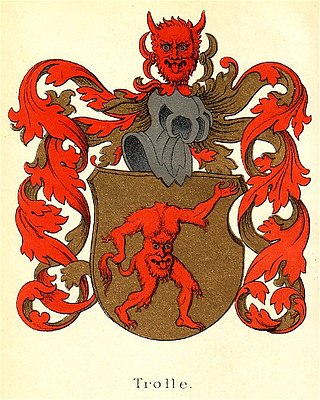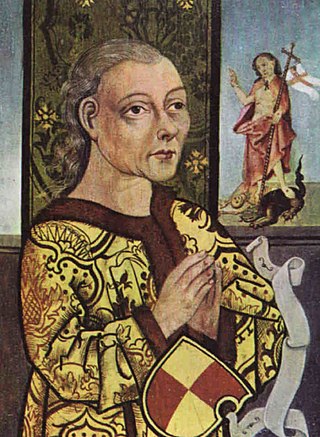
Sten Sture the Younger, was a Swedish nobleman who served as the regent of Sweden, during the era of the Kalmar Union.
Erik Trolle was elected regent of Sweden in 1512, during the era of Kalmar Union. He was Justiciar of Närke and a Lord High Councillor of Sweden from 1487.

Kettil Karlsson (Vasa) (c. 1433 – 11 August 1465) was a Swedish clergyman, diplomat, military leader and statesman during the Kalmar Union era. He was a member of the house of Vasa. At age 25, he was elected Bishop of Linköping. He rebelled against King Christian I in 1463, was Captain General (rikshövitsman) and de facto regent of Sweden from February to August 1464, stepping down during the brief return of King Charles Canutesson from exile. After falling out with King Charles, Kettil Karlsson was subsequently elected Lord Protector and Regent (riksföreståndare) of Sweden from 26 December 1464 to his death.

Erik Axelsson (Tott) (c. 1419–1481) was a Dano-Swedish statesman who served as the regent of Sweden under the Kalmar Union, jointly with Jöns Bengtsson Oxenstierna in 1457 and alone from 1466 to 1467.

Karl Knutsson Bonde, also known as Charles VIII and called Charles I in Norwegian contexts, was King of Sweden and King of Norway (1449–1450).

Sture was a name borne by three distinct but interrelated noble families in Sweden in the Late Middle Ages and Early Modern Period. It was originally a nickname, meaning 'haughty, proud', but later became a surname. Particularly famous are the three regents from these families who ruled Sweden in succession during the fifty-year period between 1470 and 1520, namely:
Eric Bielke, also known as Eerikki Tuurenpoika and Eric Tureson, royal councillor of Sweden, knighted, feudal fiefholder or margrave of Vyborg Castle.
The Lord High Constable was a prominent and influential office in Sweden, from the 13th century until 1676, excluding periods when the office was out of use. The office holder was a member of the Swedish Privy Council and, from 1630 and on, the head of the Swedish Council of War. From 1634, the Lord High Constable was one of five Great Officers of the Realm.

Vyborg Castle is a fortress in Vyborg, Russia. It was built by the Swedes during the Middle Ages around which the town of Vyborg evolved. The castle became the stronghold of the Swedish realm in the Karelian region. Throughout the centuries, it was the first defense of the kingdom against the Russians. Its military and strategic status in the late Middle Ages was second only to the fortified capital Stockholm. Currently it serves as the site of Vyborg Regional Museum.
The Fief of Viborg (1320–1534) was for two centuries a late medieval fief in the southeastern border of Finland and the entire Swedish realm. It was held by its chatelain, a fief-appointed feudal lord.

The House of Trolle is the name of a noble family, originally from Sweden. The family has produced prominent people in the histories of Sweden and Denmark since the Middle Ages and is associated with several estates in both countries.

Bergkvara is a manor house and ruined castle (slottsruin), located at the north beach of Bergkvarasjön in Växjö, Sweden, and described in Nordisk familjebok as "one of Sweden's oldest mansions in Värend, Bergunda and Öjaby parishes, Kinnevalds district and Kronoberg County, 6 km. west of Växjö".

Magdalena of Sweden was a Swedish princess. She was the daughter of King Karl Knutsson and his first queen consort, Catherine Karlsdotter. In 1468–1470, her spouse Ivar Axelsson (Tott) was the promised successor of her father as regent.

Stegeborg Castle is a ruined castle in St Anna parish, Söderköping, Östergötland, located on an island in a narrow sound at the bay of Slätbaken, Sweden.

Katarina Erikintytär Nipertz was a Swedish noblewoman and fiefholder of Raseborg Castle, Sweden.
The Battle of Haraker was fought on 17 April 1464 at the village of Haraker, Västmanland, approximately 20 kilometers north of the city of Västerås in Sweden. The Swedish separatist army, under the command of the Bishop of Linköping, Kettil Karlsson, defeated King Christian I's Danish army.
Ture Turesson (Bielke) (1425–1489/90) was a Swedish statesman and military commander and a prominent leader of the unionist party during the Kalmar Union period. He was a Privy Councillor and Castellan of Axvall Castle during the reign of separatist King Charles Canutesson, before defecting to the unionist side in 1452, spending several years in exile in Denmark. He was appointed Lord High Constable of Sweden, Castellan of Stockholm and Kalmar and Captain-General during the reign of King Christian I, and commanded the unionist forces during several major battles during the turbulent 1460s, before surrendering to Sten Sture the Elder's separatists in 1472. During his later years he was Lawspeaker of the province of Öland.

Sten Sture's war against the Totts (Swedish: Sten Stures kamp mot Tottarna or the Fight between Sten Sture and Ivar Axelsson refers to a conflict between forces under Sten Sture the Elder and the Tott family in 1487.











